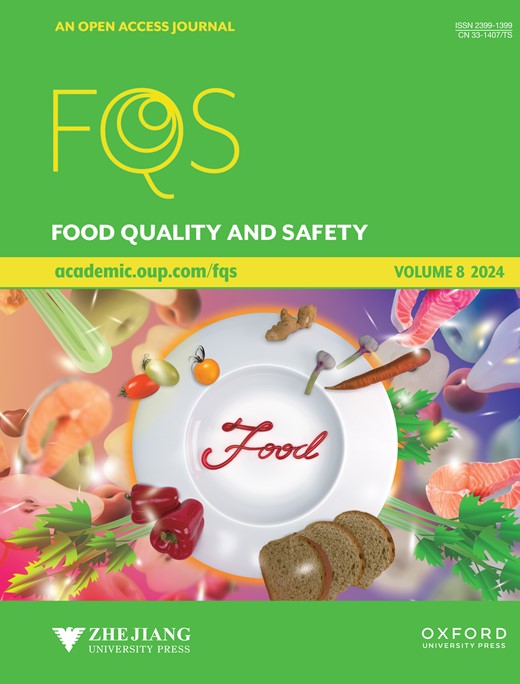Effect of cinnamaldehyde on Rhizopus stolonifer and on the conservation of sweetpotato
IF 4.4
3区 农林科学
Q2 FOOD SCIENCE & TECHNOLOGY
引用次数: 0
Abstract
Rhizopus stolonifer (R. stolonifer) causing soft rot of sweetpotato resulted in postharvest substantial loss of economy. The antifungal effect and mechanism of cinnamaldehyde (CIN) against R. stolonifer were explored by biochemical analysis and RNA-sequencing in this research, and the edible quality of CIN-treated sweetpotato was evaluated. The results showed that CIN inhibited the growth of R. stolonifer and reduced the incidence of soft rot in sweetpotato at a minimum inhibitory concentration of 1000 μL/L. The damage of cell walls of R. stolonifer by CIN was associated with the up-regulation of CHT1. Cytosolic leakage and malondialdehyde (MDA) content increased following CIN-treatment, which was correlated to higher ROS levels and lower catalase activity. Up-regulation of ERG genes and oxidative stress-related genes following CIN treatment was associated with impaired cell membrane integrity. The mitochondrial structure of R. stolonifer was damaged by CIN treatment resulting in lower respiration rates and ATP production, which was correlated with lower expressions of IDH1, COX4 and QCR7. Our research suggested that the inhibition of CIN on R. stolonifer was related to the disruption of its normal gene expression network. And CIN maintained the nutritional and edible quality of sweetpotato. This study provides valuable insights into the antifungal mechanism of CIN on R. stolonifer and the maintenance of root quality, which contributes to efficient use of CIN on controlling soft rot of sweetpotato.肉桂醛对根瘤菌和甘薯保护的影响
导致甘薯软腐病的匍匐茎根瘤菌(Rhizopus stolonifer,R. stolonifer)会给收获后的甘薯造成巨大的经济损失。本研究通过生化分析和 RNA 序列分析探讨了肉桂醛(CIN)对 R. stolonifer 的抗真菌作用及其机制,并对 CIN 处理过的甘薯的食用品质进行了评价。结果表明,在最低抑制浓度为 1000 μL/L 时,CIN 可抑制 R. stolonifer 的生长,降低甘薯软腐病的发病率。CIN 对 R. stolonifer 细胞壁的破坏与 CHT1 的上调有关。CIN 处理后细胞膜渗漏和丙二醛(MDA)含量增加,这与 ROS 水平升高和过氧化氢酶活性降低有关。CIN处理后ERG基因和氧化应激相关基因的上调与细胞膜完整性受损有关。CIN 处理破坏了匍匐茎 R. 的线粒体结构,导致呼吸速率和 ATP 生成量降低,这与 IDH1、COX4 和 QCR7 表达量降低有关。我们的研究表明,CIN 对匍匐茎的抑制作用与其正常基因表达网络的破坏有关。而 CIN 能保持甘薯的营养和食用品质。这项研究为了解 CIN 对匍匐茎根瘤菌的抗真菌机制以及保持根部品质提供了宝贵的见解,有助于有效利用 CIN 控制甘薯软腐病。
本文章由计算机程序翻译,如有差异,请以英文原文为准。
求助全文
约1分钟内获得全文
求助全文
来源期刊

Food Quality and Safety
FOOD SCIENCE & TECHNOLOGY-
CiteScore
7.20
自引率
1.80%
发文量
31
审稿时长
5 weeks
期刊介绍:
Food quality and safety are the main targets of investigation in food production. Therefore, reliable paths to detect, identify, quantify, characterize and monitor quality and safety issues occurring in food are of great interest.
Food Quality and Safety is an open access, international, peer-reviewed journal providing a platform to highlight emerging and innovative science and technology in the agro-food field, publishing up-to-date research in the areas of food quality and safety, food nutrition and human health. It promotes food and health equity which will consequently promote public health and combat diseases.
The journal is an effective channel of communication between food scientists, nutritionists, public health professionals, food producers, food marketers, policy makers, governmental and non-governmental agencies, and others concerned with the food safety, nutrition and public health dimensions.
The journal accepts original research articles, review papers, technical reports, case studies, conference reports, and book reviews articles.
 求助内容:
求助内容: 应助结果提醒方式:
应助结果提醒方式:


